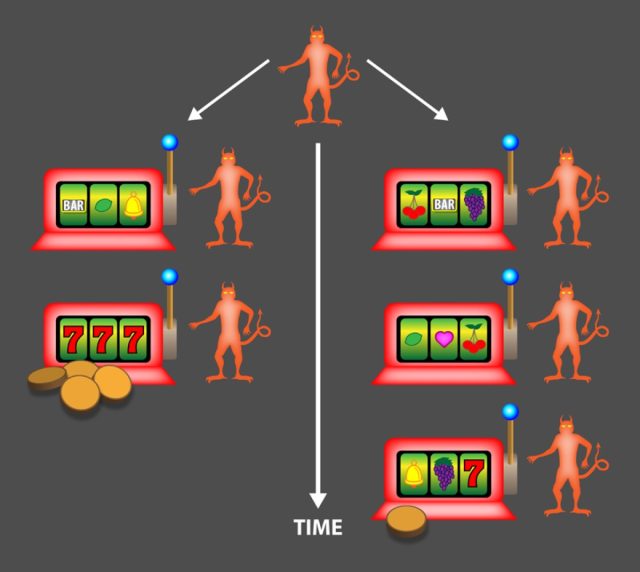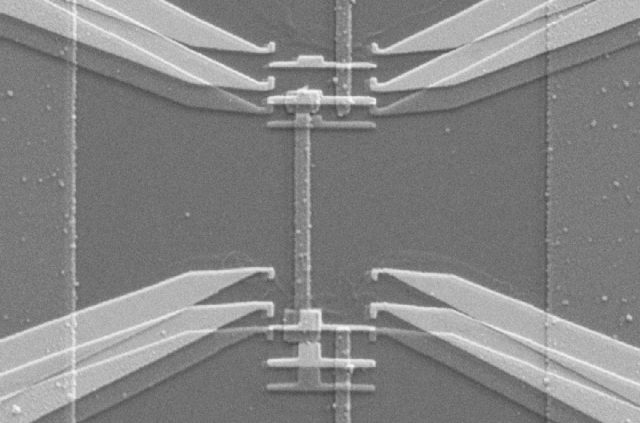Know when to walk away, know when to run —
Physicists even demonstrated the basic principle in a nanoscale electronic device.
Jennifer Ouellette
–

Enlarge / In a new version of the classic 19th-century thought experiment, Maxwell’s demon plays the role of a gambler who knows when to quit while it’s ahead.
Entropy (aka the second law of thermodynamics) is a harsh mistress. If you think of the universe as a cosmic casino, the laws of thermodynamics amount to the house edge: you can’t win, you can’t break even, and—barring opening a portal to an alternate universe with different physical laws—you can’t get out of the game. You just have to keep playing and hopefully come up with successful strategies to minimize your losses as much as possible—and maybe even come out ahead occasionally, at least in the short term.
That’s the essence of a new paper published in the journal Physical Review Letters. The paper updates a classic 19th-century thought experiment known as Maxwell’s demon, which provides a potential loophole to subvert the second law—at least temporarily. Now physicists have proposed a gambling version of the demon playing a slot machine, unable to control when the machine pays out (in terms of free energy available for work) but able to choose when to stop playing to maximize its “winnings.” The research might one day lead to improved efficiency of microscopic heat engines and motors.
As we’ve reported previously, around 1870, James Clerk Maxwell envisioned a tiny imp capable of creating order out of disorder in a closed container filled with gas. The imp accomplished this by making heat flow from a cold compartment to a hot one in apparent violation of the second law. The two compartments would be separated by a wall with a shutter covering a pinhole just large enough for a gas molecule to pass through.
Maxwell’s hypothetical imp would perch atop the dividing wall and open and close the shutter at will. Gas molecules would generally be highly disordered (high entropy), in the sense that they have roughly the same average speed and temperature and they would therefore be close to equilibrium. So there would not be much energy available for “work”—defined in physics as the force over a given distance (W=fd).
Because the atoms that make up the molecules are constantly in motion, there will be small fluctuations over time. Whenever the demon spots a molecule moving a bit faster near the pinhole in the right (cold) compartment, it will open the shutter and let the molecule pass through to the left (hot) compartment. The imp does the same for any slow-moving gas molecules in the left compartment, allowing them to pass into the colder right compartment. So the molecules in the left compartment get hotter and hotter, while the ones in the right get colder and colder, in an apparent reversal of entropy. Once you have that temperature difference, you basically have a heat pump capable of performing useful work.
Statistically, of course, it’s well-nigh impossible to sort and separate billions of single molecules by speed or temperature. In principle, a huge amount of additional energy would be required. Maxwell’s demon supplies that extra energy, so the thought experiment is not a truly closed system, and there’s no violation of the second law.
Physicists have come up with some pretty clever experiments to bring some version of the demon to the laboratory. For instance, Scottish scientists devised an “information ratchet” in 2007 to create a temperature difference in chemical systems that would otherwise be in thermal equilibrium. The following year, University of Oregon researchers devised an ingenious version using laser light to create a box, with two other lasers to serve as a trapdoor barrier and a sorting “demon,” respectively.

Enlarge / In the new thought experiment, the demon repeatedly plays a slot machine that might or might not pay out free energy (gold coins). The demon employs a strategy that allows it to either keep playing for a fixed time period (right) or to decide to stop sooner if the winnings are good (left).
G. Manzano et al./APS/Alan Stonebraker
Japanese physicists figured out how to coax a nanoscale bead up a spiral staircase in a 2010 paper in Nature, based on the concept of Szilard’s engine. In 2013, German scientists built an experimental equivalent of Maxwell’s demon out of a pair of interacting quantum dots (tiny bits of semiconductors just a few nanometers wide). And in 2018, Penn State physicists rearranged a random array of atoms into organized blocks to create a quantum equivalent of Maxwell’s demon.
For this latest paper, co-author Gonzalo Manzano of the International Centre for Theoretical Physics (ICTP) in Trieste, Italy, and his colleagues wondered if they could devise a strategy that didn’t require the high level of control of the original thought experiment, while still allowing the demon to create that all-important asymmetry to harvest energy for work. In this new version, the microscale demon can only passively observe as the shutter opens and closes automatically—and unpredictably. Depending on whether hot and cold particles are successfully being separated with each opening and closing of the shutter, the demon must choose whether to continue to “play” the game or stop and start over.
In essence, the demon is gambling on the outcome of a molecular-scale slot machine, deciding after each spin whether to keep playing or to stop. Each turn incurs a cost in work, akin to the cost of each spin. The gambling demon must determine the best strategy to eke out a temporary net gain in its energy winnings by exploiting the occasional random fluctuations in the motion of the particles. “One way to develop successful strategies is to stop when things are somehow ‘getting bad’ to avoid major losses,” Manzano told APS Physics.

Enlarge / Scanning electron micrograph shows the device used to implement the gambling demon. The tapered structures on each side are electrodes from which single electrons can jump onto the strip-shaped copper island in between. Each jump is like a gas molecule passing through the demon’s shutter.
G. Manzano et al., 2021
Manzano et al. found that there was no single successful strategy: some “stopping” strategies were successful, and others were not. Even the successful ones only worked in the short term. Play the game long enough, and entropy always wins out in the end. The authors found that the key to getting a temporary net energy gain for any given run is to ensure that the sequence of opening and closing the shutter breaks time-reversal symmetry (in keeping with the arrow of time that governs our macroscale existence).
This was borne out by an experimental nano-electronic device that the team set up with the help of Aalto University physicist Jukka Pekola, in which single electrons tunnel into a metallic island. As Philip Ball wrote at APS Physics:
[The device] consists of electrodes separated from a metallic island by a gap. When cooled to a fraction of a degree kelvin, individual electrons can jump between the island and the electrodes. A voltage applied to the island controls the chances of jumping and thus acts like a trapdoor. When an electron jumps onto the island, heat extracted from the electrode can be converted into work; conversely, when an electron jumps from the island to an electrode, heat is dissipated.
An approach like the gambling demon might one day improve the performance of micromotors like thermal ratchets. The researchers maintain that their gambling demon should also function in the quantum realm, raising the possibility of quantum devices that can temporarily beat the second law to extract work from random quantum jumps.
DOI: Physical Review Letters, 2021. 10.1103/PhysRevLett.126.080603 (About DOIs).

